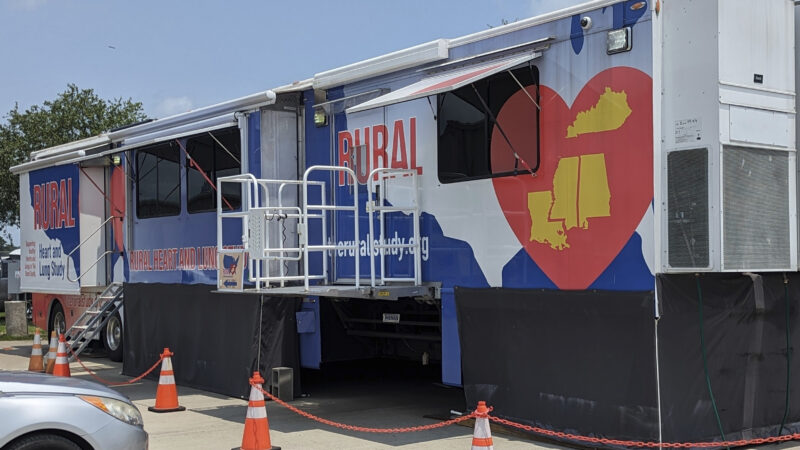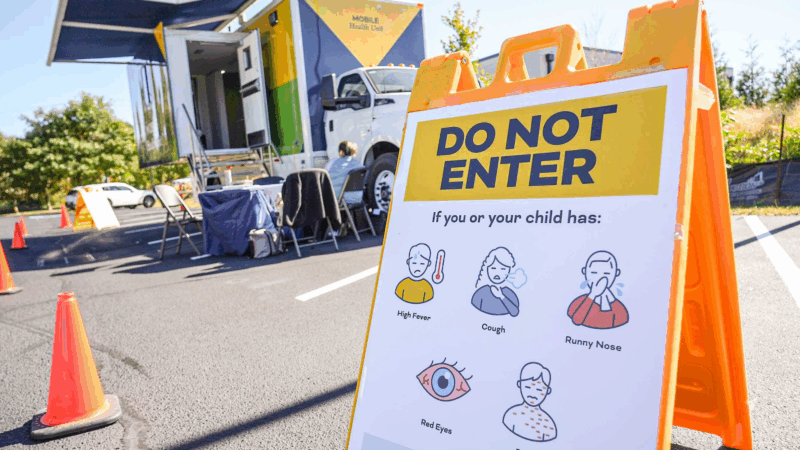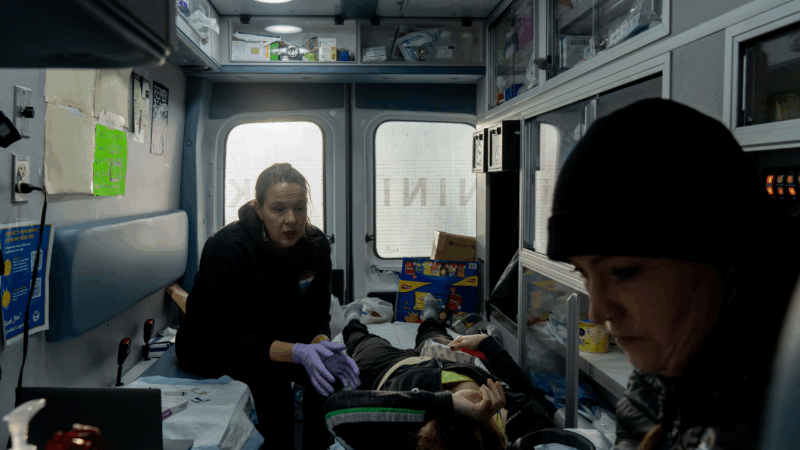Heart disease is rampant in parts of the rural South. Researchers are hitting the road to learn why
A medical trailer, being used to test rural residents' heart and lung function as part of a study to determine why the rates of heart and lung disease are so much higher in the rural South, is seen, May 8, 2024, in Napoleonville, La.
By Sudhin Thanawala
Darrell Dixon’s father was just 25 when he had a major heart attack in the rural Mississippi Delta. By his early 40s, a series of additional attacks had left his heart muscle too weak to pump enough blood to his body. He died in 2013 at the age of 49.
“It was a big jolt for our family,” Dixon, 36, recalled. “For myself, personally, it also got me thinking about heredity. I just wondered whether I was next.”
The death spurred Dixon to get involved in an unusual and ambitious new health study.
Public health experts from some of the nation’s leading research institutions have deployed a massive medical trailer to rural parts of the South to test and survey thousands of local residents. The goal: to understand why the rates of heart and lung disease are dramatically higher there than in other parts of the U.S.
“This rural health disadvantage, it doesn’t matter whether you’re white or Black, it hurts you,” said Dr. Vasan Ramachandran, a leader of the project who used to oversee the Framingham Heart Study — the nation’s longest-running study of heart disease. “No race is spared, although people of color fare worse.”
The researchers aim to test the heart and lung function of roughly 4,600 residents of 10 counties and parishes in Alabama, Kentucky, Louisiana and Mississippi while collecting information about their environments, health history and lifestyles. They are also giving participants a fitness tracker and plan to survey them repeatedly for years to check for any major medical events.
Ramachandran, now dean of the University of Texas School of Public Health in San Antonio, said rural populations in the U.S. rarely receive such personal, long-term attention from epidemiologists. More than a dozen institutions are helping with the study, including Johns Hopkins University, the University of California, Berkeley, and Duke University.
The 52-foot-long (16-meter-long), 27-ton trailer is outfitted with instruments that examine calcium in the arteries, the structure of the heart, lung capacity and other, more common health indicators such as blood pressure and weight. The initial exam can take more than three hours.
“They’re reaching out and going out into the community in ways that I have not seen before,” said Lynn Spruill, the mayor of Starkville, Mississippi, in Oktibbeha County, where the trailer arrived in 2022 and medical staff tested more than 700 people.
Studies and data from U.S. health officials show rural populations in the U.S. are unhealthier and have lower life expectancy than Americans in urban areas. The health disparity is even greater in the South, where mortality rates from heart disease — the leading cause of death in the U.S. — for people 35 and older are more than twice the national average in some rural communities. Lung conditions such as chronic obstructive pulmonary disease, or COPD, which the study is also examining, are also more prevalent in the South.
Researchers have multiple theories for the disparity. Hospital closures and physician shortages have left many rural residents with limited access to care. Healthy food, fitness opportunities and public transit are often scarcer. Poverty rates are higher, and fewer people receive health coverage through their employers. In the rural South, poverty rates and the share of people without health insurance are even greater.
Smoking cigarettes is a major cause of heart disease, and at least 20% of adults smoked in Alabama, Kentucky, Louisiana and Mississippi, according to 2019 data from the U.S. Centers for Disease Control and Prevention. Obesity is another factor. In 2022, self-reported height and weight put between 38% and 40% of adults in the four states in the obese body mass index category.
By closely examining local residents and their environments, the rural study seeks clearer answers about what’s driving the additional health burden in the South. Researchers also want to understand what makes some rural counties there much healthier than others.
“We’re interested in both the risk, but also the resilience piece of it,” said Lindsay Pool, an epidemiologist with the National Heart Lung and Blood Institute, which has awarded more than $40 million for the study.
To accomplish that goal, researchers are also visiting rural areas with low risk for heart and lung disease in three of the states — Louisiana, Mississippi and Kentucky — despite similar demographics.
Oktibbeha County, home to Mississippi State University, in the eastern part of Mississippi near the Alabama border, is the low-risk location. The researchers are contrasting it with Panola County in northern Mississippi about 60 miles (97 kilometers) south of Memphis, Tennessee.
Both counties have poverty rates that exceed 20% and a similar and sizeable share of people under 65 without health insurance. But between 2019 and 2021, the death rate from heart disease for those 35 and over was 647 per 100,000 people in Panola County compared to 395 per 100,000 in Oktibbeha County, according to CDC data.
In more urban Rankin County, Mississippi, part of the Jackson metro area, the figure was 331. The U.S. average over the same period was 326.
Dixon, who works in Panola County for a regional development organization and serves as a consultant for the heart and lung study, helped recruit more than 600 Panola County residents for the project. Heart conditions are so prevalent there that it’s common to hear people discussing their medications and side effects at local shops and churches, he said.
Dixon’s father, Darrell Dixon Sr., lived in Clarksdale, about 40 miles (64 kilometers) west of Panola County. He long suffered from high blood pressure and had a strong family history of heart disease.
He had an additional major heart attack after an inmate he had grown close to as chaplain of the Mississippi State Penitentiary was executed, Dixon said, and then spent the last years of his life in and out of the hospital with congestive heart failure.
“He really suffered,” Dixon said. He hopes the study will shed light on any unseen environmental factors that may have played a role in his dad’s death and raise awareness among local residents about “how to live better.”
The trailer is now in Louisiana’s northeastern Franklin Parish, where the death rate from heart disease between 2019 and 2021 was a whopping 859 per 100,000 people for those 35 and over, according to the CDC data. About 200 miles (322 kilometers) south in New Orleans, it was 340.
The National Heart, Lung and Blood Institute plans to extend the study to 2031, and researchers hope to examine all the participants in person again.
“The longer you can follow people, the more you can understand disease development and progression,” Pool, the epidemiologist, said.
Justice Department opens investigation into Minnesota governor and Minneapolis mayor
Federal prosecutors are investigating Gov. Tim Walz and Mayor Jacob Frey.
No sign of new protests in Iran as a hard-line cleric calls for executions
A Iran returns to an uneasy calm after protests led to a violent crackdown, a senior cleric is calling for the death penalty for detained demonstrators. His sermon Friday also threatened U.S. President Trump.
Gulf South food banks look back on a challenging year as another shutdown looms
Federal funding cuts and a 43-day government shutdown made 2025 a chaotic year for Gulf South food banks. For many, the challenges provide a road map for 2026.
Measles is spreading fast in S.C. Here’s what it says about vaccine exemptions
More than 550 people have contracted measles in Spartanburg County, S.C., in a fast-growing outbreak. Like a majority of U.S. counties, nonmedical exemptions to school vaccination are also rising.
It took 75 governors to elect a woman. Spanberger will soon be at Virginia’s helm
Abigail Spanberger, a former CIA officer and three-term congresswoman, is breaking long-held traditions on inauguration day. She says she wants her swearing-in to showcase the state's modern vibrancy.
For those with addiction, going into and coming out of prison can be a minefield.
Many jails and prisons around the country don't provide medication treatment for opioid use disorder. Studies show that medication makes recovery more likely and reduces the risk of overdose death.








